The Mexican government has reiterated its request to Austria to return a precious Aztec headdress of feathers and gold. Currently on display at the Weltmuseum in Vienna, legend has it that this “penacho” belonged to Emperor Moctezuma (1466-1520).
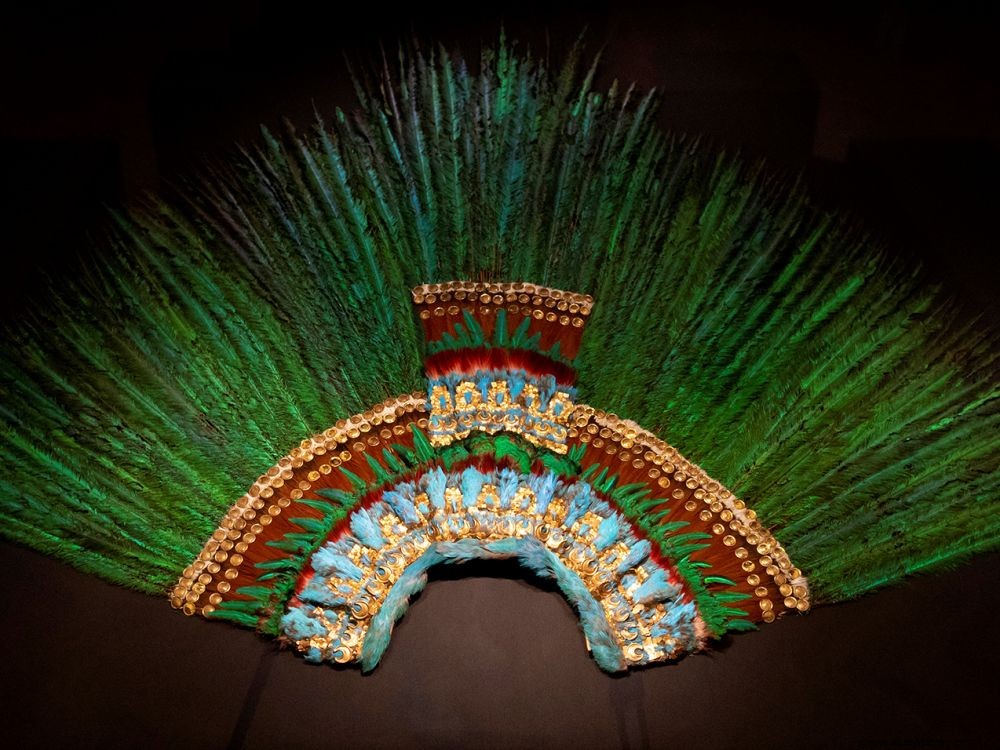
This Aztec headdress called "El Penacho" is on display at the Welt Museum in Vienna, Austria. Present in this country for several centuries, its return has been demanded by the Mexican government.
With its long emerald-colored quetzal bird feathers and gold metallic applications, a priceless Aztec headdress, symbol of the glorious past of the pre-Columbian world, crystallizes tensions between Mexico and Austria... A country where it has been kept for 500 years ! Mexican President Andres Manuel Lopez Obrador has indeed recently entrusted his wife Beatriz Gutierez Müller with convincing the Austrian authorities to release the "Penacho" exhibited at the Weltmuseum in Vienna, so that the precious crown of feathers is temporarily presented in Mexico in 2021 during the celebrations of the 200 years of the country's independence.
The feather tiara would be "really too fragile" to be moved
For the Weltmuseum in Vienna, the former Museum of Ethnology in the Austrian capital, the problem lies elsewhere:the claimed feather tiara is "really too fragile" to be moved. The unique headdress, 1.30m high, 1.63m wide and only 850 grams, is now kept in a showcase specially designed to withstand the vibrations of visitors' footsteps. "Can you imagine it's over 500 years old!", recalls Gérard van Bussel, curator of the museum, who responded to AFP. "Of all the headdresses from the pre-colonial era, this is the only one that has survived"! What the two countries had already agreed upon, following a major restoration carried out on the crown of feathers between 2010 and 2012 by Austrian and Mexican specialists alike.
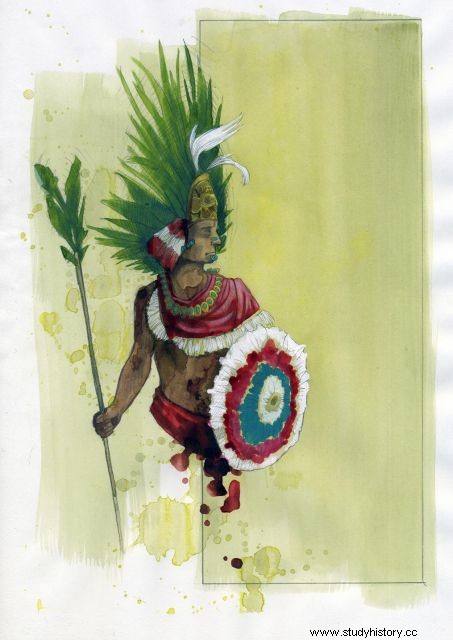 Illustration of Moctezuma (1466-1520), the Aztec emperor. ©Alessandro Lonati/Leemage/Afp
Illustration of Moctezuma (1466-1520), the Aztec emperor. ©Alessandro Lonati/Leemage/Afp
It is not known precisely how the "Penacho "went to Europe, but the earliest written record of it can be found in a collection of the Habsburg dynasty in the late 16th century. From the bloody twilight of the Aztec Empire in 1521, Spanish ships began to transporting great treasures from New Spain to the Old World. And fabulous objects ended up in Europe. Thus, about 75 years after the conquest of the Aztec capital by the Spaniards, a headdress described as "Morisque" composed of magnificent feathers and gold plates is mentioned in 1596 in the inventory of a castle in the Austrian Alps!
Is it the same crown of feathers as that described in the first letter addressed to King Charles V by Hernan Cortès, in July 1519, when sending rich presents? "A large and colorful headdress that sits on the head with 68 gold elements" . Still, these remarkable achievements of the amantecas, the feather craftsmen from Mexico, will be numerous to cross the Atlantic, whether it is headdresses or shields of warriors (cimalli ). "The story of objects entering Europe by Charles V, then from Charles V to Archduke Ferdinand II is a myth that persists and cannot be proven" , explains the curator of the Vienna museum, interviewed during a documentary on "El penacho de Moctezuma, plumaria del Mexico antiquo », filmed in 2014 by Mexican director and author Jaime Kuri Aiza.
With its long emerald-colored quetzal bird feathers and gold metallic applications, a priceless Aztec headdress, symbol of the glorious past of the pre-Columbian world, crystallizes tensions between Mexico and Austria... A country where it has been kept for 500 years ! Mexican President Andres Manuel Lopez Obrador has indeed recently entrusted his wife Beatriz Gutierez Müller with convincing the Austrian authorities to release the "Penacho" exhibited at the Weltmuseum in Vienna, so that the precious crown of feathers is temporarily presented in Mexico in 2021 during the celebrations of the 200 years of the country's independence.
The feather tiara would be "really too fragile" to be moved
For the Weltmuseum in Vienna, the former Museum of Ethnology in the Austrian capital, the problem lies elsewhere:the claimed feather tiara is "really too fragile" to be moved. The unique headdress, 1.30m high, 1.63m wide and only 850 grams, is now kept in a display case specially designed to withstand the vibrations of visitors' footsteps. "Can you imagine it's over 500 years old!", recalls Gérard van Bussel, curator of the museum, who responded to AFP. "Of all the headdresses from the pre-colonial era, this is the only one that has survived"! What the two countries had already agreed upon, following a major restoration carried out on the crown of feathers between 2010 and 2012 by Austrian and Mexican specialists alike.
 Illustration of Moctezuma (1466-1520), the Aztec emperor. ©Alessandro Lonati/Leemage/Afp
Illustration of Moctezuma (1466-1520), the Aztec emperor. ©Alessandro Lonati/Leemage/Afp
It is not known precisely how the "Penacho "went to Europe, but the earliest written record of it can be found in a collection of the Habsburg dynasty in the late 16th century. From the bloody twilight of the Aztec Empire in 1521, Spanish ships began to transporting great treasures from New Spain to the Old World. And fabulous objects ended up in Europe. Thus, about 75 years after the conquest of the Aztec capital by the Spaniards, a headdress described as "Morisque" composed of magnificent feathers and gold plates is mentioned in 1596 in the inventory of a castle in the Austrian Alps!
Is it the same crown of feathers as that described in the first letter addressed to King Charles V by Hernan Cortès, in July 1519, when sending rich presents? "A large and colorful headdress that sits on the head with 68 gold elements" . Still, these remarkable achievements of the amantecas, the feather craftsmen from Mexico, will be numerous to cross the Atlantic, whether it is headdresses or shields of warriors (cimalli ). "The story of objects entering Europe by Charles V, then from Charles V to Archduke Ferdinand II is a myth that persists and cannot be proven" , explains the curator of the Vienna museum, interviewed during a documentary on "El penacho de Moctezuma, plumaria del Mexico antiquo », filmed in 2014 by Mexican director and author Jaime Kuri Aiza.
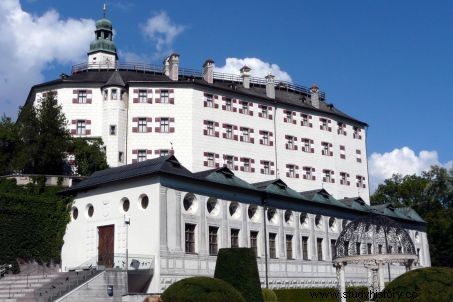 Castle of Ambras, Tyrol, where the presence of the so-called crown of Moctezuma appears in an inventory dating back to the end of the 16th century century. ©Emmanuel Brunner/Wikipedia Commons
Castle of Ambras, Tyrol, where the presence of the so-called crown of Moctezuma appears in an inventory dating back to the end of the 16th century century. ©Emmanuel Brunner/Wikipedia Commons
Before arriving at the Vienna Museum, the crown of feathers had indeed found itself in the Cabinet of Curiosities of the Archduke of Austria Ferdinand II, in his castle of Ambras, near Innsbruck, in Tyrol. Before Emperor Rudolf II inherited it on the Archduke's death. However forgotten, the headdress would remain in the castle of Ambras for a few more centuries. Transferred to Vienna only in the 19 th century, the Penacho was exhibited to the public for the first time in 1889. Then, from the city's natural history museum, it moved to that of Ethnology, before being kept with other treasures during the Second World War in the national bank from Austria. Presented in Zurich (Switzerland) in 1946-1947 – its only appearance outside the Austrian borders – the feather headdress will return to Vienna where it has since remained in the Museum of Ethnology, in the meantime baptized Weltmuseum.
Why is it called "Moctezuma's Crown"?
There is nothing to indicate that it is indeed an object that was worn by the Aztec ruler. For experts, Mexican rulers wore a kind of triangular diadem instead. On the other hand, there is no doubt that such a headdress could only have been possessed by a very high dignitary. Despite its popular attribution to Moctezuma, this crown is not considered to have really belonged to this tlatoani (name of the Aztec sovereigns), but no doubt it was part of a set of gifts that the Mexican monarch had granted Cortés with the intention of freeing himself from them to keep him away from his empire...
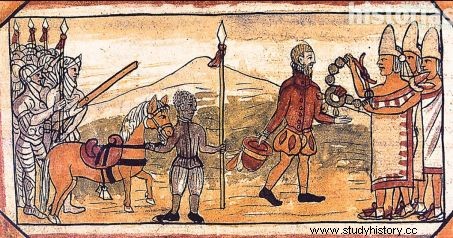 Anonymous work from the Codex Duran (1579), kept at the National Library of Madrid (Spain), presenting the meeting of Hernan Cortes (1485-1547) and Emperor Moctezuma (1466-1520). The forehead of the dignitaries is surrounded by a triangular diadem. © Leemage /AFP
Anonymous work from the Codex Duran (1579), kept at the National Library of Madrid (Spain), presenting the meeting of Hernan Cortes (1485-1547) and Emperor Moctezuma (1466-1520). The forehead of the dignitaries is surrounded by a triangular diadem. © Leemage /AFP
In Mexico, specialists do not imagine any transfer of the object from Europe. It's already "a miracle “that it could have been preserved, underlines Ivan Escamilla, researcher of the National University, interviewed by AFP. So why revive a question that seems already settled? ”Mr. Lopez Obrador plays with symbols" , analyzes the historian and political scientist Jose Antonio Crespo, and "this headdress is one of them", because it embodies the grandeur of the pre-Columbian world. More broadly, this request is part of a debate on the restitution of cultural property "looted" during the colonial periods.
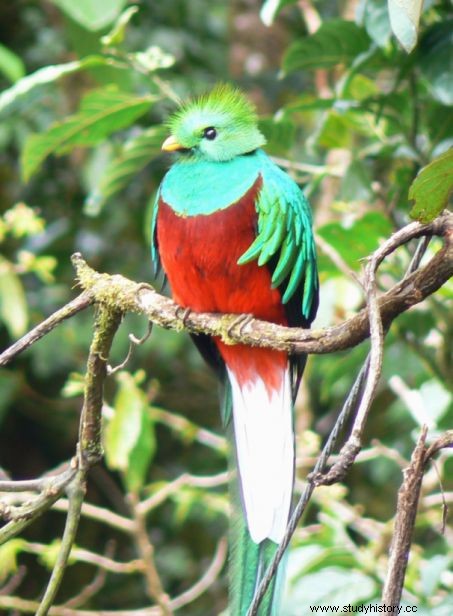 Quetzal bird from the neotropical zone of Central America with green and blue plumage. Only the males have long tail feathers. The name of this bird comes from the Nahuatl quetzalli, which means "big green feather". It is also present in the name of the Mexican god Quetzalcoatl, which means “feathered serpent” or “quetzal serpent”. ©D. Hatcher / Public domain
Quetzal bird from the neotropical zone of Central America with green and blue plumage. Only the males have long tail feathers. The name of this bird comes from the Nahuatl quetzalli, which means "big green feather". It is also present in the name of the Mexican god Quetzalcoatl, which means “feathered serpent” or “quetzal serpent”. ©D. Hatcher / Public domain
Among the ancient Aztecs, feathers were one of the most important elements of religious symbolism as well as to mark authority. Throughout Mesoamerica, wearing feathers was used as a language. One of the most important deities of the pre-Hispanic world was precisely Quetzalcoatl , the Feathered Serpent God.
B.A with AFP
